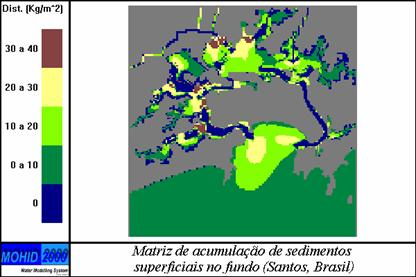MOHID Water
Sediment Dynamics

The sediment dynamics in aquatic systems is governed by the combined action of waves and currents. Moreover, the sediment motion is affected by the inherent sediment characteristics. The MOHID modelling system allows simulating sediment transport and morphological evolution of natural systems composed of different sediment types (cohesive and non-cohesive). The modelling of sediment transport and hydrodynamics are intrinsically related. The bathymetry changes affect the hydrodynamics which in turns modify the sediment transport. MOHID can also be coupled to wave models (e.g., SWAN). Particularly in the surf zone, waves may induce considerable changes in mean sea level and strong currents. Two-dimensional (2DH) or three-dimensional (3D) discretisation can be adopted. The simulation of bed evolution for long time periods is possible by the speed up of morphological changes by an acceleration factor and by the domain decomposition parallelisation approach implemented using MPI directives.
Cohesive sediments (commonly called mud) are transported in suspension primarily as flocculated material. Thus, MOHID accounts for the transport of cohesive sediments by advection-diffusion and flocculation process that increase settling velocities. The consolidation of cohesive beds is another important process that increases the resistance to erosion. To represent bottom stratigraphy, the sediment column can be divided into several layers. Beyond the importance of cohesive sediments for engineering studies (e.g., siltation of marinas, harbours and navigation channels in estuarine systems), it is also relevant for water quality concerns (e.g., algae growth and contaminants transport).
The transport of non-cohesive sediments (sand fractions) can be divided into bed load (in close contact with the bed) and suspended load. The bed load transport can be computed by MOHID considering, e.g., the effects of bed slope and wave asymmetry. The transport of sand in suspension can be inferred through the use of empirical relations or explicitly computing the advection-diffusion equation. Multiple sand fractions can be taken into account to consider the effects of mixed size fractions on sediment motion. Furthermore, cohesive particles can fill the spaces between sand grains increasing their resistance to removal and, when bed starts to have cohesive behaviour, even prevent bed load transport from occurring. The sorting of sediments is observed, e.g., in different zones of estuarine systems and beach profiles.


